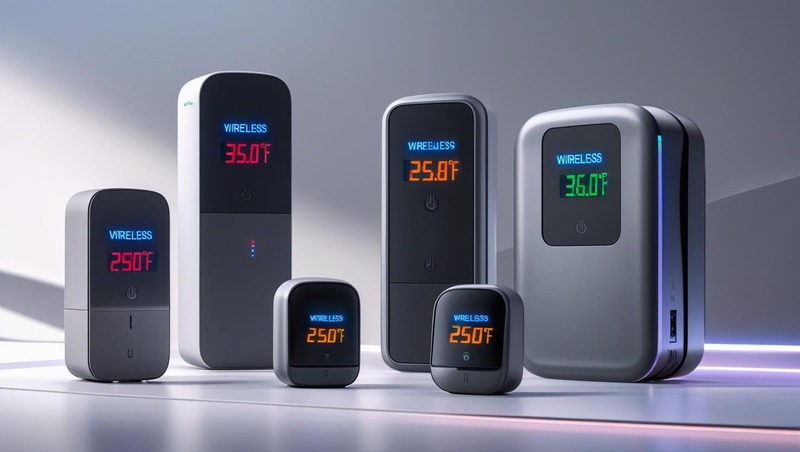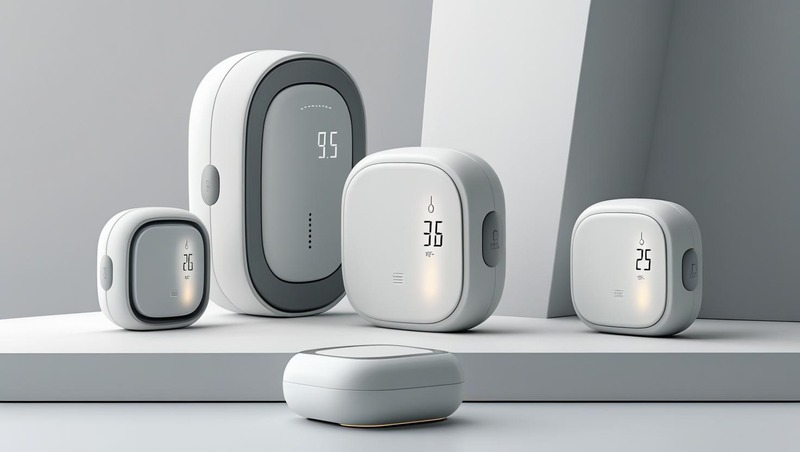The wireless temperature sensors market is poised for significant growth through 2030, driven by increasing demand across industrial automation, smart infrastructure, healthcare, food safety, logistics, and environmental monitoring. Wireless sensors provide critical advantages over traditional wired systems, including easy deployment, lower maintenance, remote accessibility, and cost-effective scalability.
https://www.marketsandmarkets.com/pdfdownloadNew.asp?id=522

Wearable devices are used for tracking several biometric parameters, such as heartbeat and body temperature. A rising number of end users are opting for wearable technology to enhance their overall health and fitness, which is driving the adoption of these electronic devices. With the advancement of technology, there is a growing need for temperature sensors in wearables like fitness trackers and smartwatches to detect and monitor physiological parameters like body temperature, heart rate, and pulse rate. It is anticipated that as technology advances, there will be a greater need for better wearables. It is anticipated that the players in the temperature sensor market will have development possibilities due to the increasing demand and increased health consciousness among people.
Market Overview
Wireless temperature sensors are devices that monitor and transmit temperature data without physical wires, using communication protocols such as Wi-Fi, ZigBee, Bluetooth, LoRaWAN, and cellular networks. These sensors are increasingly being deployed in distributed systems, hard-to-reach environments, and areas where conventional wiring is impractical or too expensive.
With rising demand for predictive maintenance, environmental control, and real-time analytics, wireless temperature sensors are becoming indispensable tools across industries. Their use is expanding from legacy applications like HVAC and food processing to more complex sectors including pharmaceuticals, cold chain logistics, automotive electronics, and smart buildings.
Key Market Drivers
The growing adoption of smart manufacturing systems and industrial automation is a primary driver. Wireless temperature sensors provide continuous feedback in factories, enabling real-time quality control, predictive maintenance, and improved process efficiency. In volatile environments such as metal forging, semiconductor fabrication, and oil refining, these sensors offer a non-intrusive way to monitor heat-intensive processes safely.
The rapid expansion of the Internet of Things ecosystem is another major catalyst. As connected devices proliferate, businesses are deploying wireless sensors to capture operational data. Temperature readings integrated into cloud platforms allow operators to detect anomalies early, saving time and reducing costs.
Energy efficiency and sustainability goals are encouraging industries to optimize temperature-dependent systems like boilers, chillers, data centers, and HVAC systems. Wireless temperature sensors help track performance and energy usage, contributing to greener operations.
In healthcare, wireless sensors are being used for continuous patient monitoring, vaccine storage, and hospital room control. Similarly, in the food and beverage industry, regulatory compliance with cold chain monitoring standards is boosting demand for reliable wireless sensing technologies.
Market Restraints and Challenges
Despite their advantages, wireless temperature sensors face challenges including signal interference, data latency, limited battery life, and security vulnerabilities. In environments with dense metal structures or electromagnetic interference, maintaining stable communication links can be difficult.
Additionally, battery-operated wireless sensors need periodic maintenance or replacement, which can be inconvenient or costly in critical or inaccessible installations. While energy harvesting technologies are emerging, they are not yet widely adopted due to cost and technical complexity.
Concerns about cybersecurity also persist. As wireless sensors become connected to networks, there is an increasing risk of data breaches or unauthorized access. This necessitates secure data transmission protocols, encryption standards, and robust network management.
Technology Trends
Recent technological advancements are addressing these limitations and expanding the capabilities of wireless temperature sensors. Ultra-low-power microcontrollers and improved battery technologies are extending sensor lifespans to several years without replacement. Some sensors now come with energy-harvesting capabilities using solar, thermal, or vibrational energy, eliminating the need for batteries altogether.
Next-generation wireless protocols such as NB-IoT (Narrowband IoT), LoRa, and 5G are providing longer range, higher reliability, and better network scalability. These advancements are particularly beneficial for remote industrial sites, smart agriculture, and municipal infrastructure monitoring.
Integration with edge computing platforms allows wireless temperature sensors to process data locally, reducing latency and enabling faster decision-making. Smart sensors equipped with AI or machine learning can also analyze temperature trends, predict anomalies, and send alerts without cloud dependency.
Additionally, form factor improvements are making sensors smaller, lighter, and easier to embed into devices or infrastructure. New sensor materials and packaging techniques are enhancing durability in extreme temperature, moisture, or vibration-prone environments.

Application Landscape
In industrial manufacturing, wireless temperature sensors are extensively used for process control in metalworks, chemical plants, pulp and paper mills, and assembly lines. They help maintain ideal operating conditions, prevent overheating, and extend equipment life.
In the automotive sector, wireless sensors are monitoring thermal conditions in engines, EV batteries, and interiors. Their role in thermal management is critical as electric vehicle adoption rises.
In logistics and cold chain operations, wireless temperature sensors ensure the integrity of temperature-sensitive goods such as pharmaceuticals, dairy, frozen foods, and chemicals. They are used in transport vehicles, warehouses, and retail freezers, often with GPS integration for location tracking.
In agriculture, these sensors are deployed in greenhouses, soil monitoring, and storage facilities to optimize crop growth and prevent spoilage. Wireless deployment simplifies coverage across large open areas.
Smart buildings are using wireless temperature sensors for HVAC optimization, energy efficiency, and occupant comfort. These sensors are often linked with occupancy and air quality sensors in integrated building management systems.
Healthcare is another high-growth area, where sensors are monitoring room temperatures, medical equipment, or patient body temperatures. The COVID-19 pandemic further accelerated the use of wireless thermal sensors for remote patient care and vaccine storage validation.
Regional Insights
North America currently leads the global wireless temperature sensors market, driven by early adoption of smart manufacturing, advanced healthcare infrastructure, and stringent regulatory standards. The United States, in particular, shows strong demand from industrial, commercial, and consumer applications.
Europe follows closely, with significant deployment across industrial automation, automotive production, and smart energy systems. Germany, the UK, and France are the primary contributors, supported by policies encouraging energy efficiency and sustainable practices.
The Asia-Pacific region is the fastest-growing market, led by China, Japan, South Korea, and India. Rapid industrialization, smart city initiatives, and rising consumer electronics production are fueling sensor demand. Government support for digitalization and the rise of domestic manufacturing giants also contribute to growth.
Latin America, the Middle East, and Africa are emerging markets with untapped potential, particularly in energy, agriculture, and logistics. Infrastructure modernization and growing awareness of IoT benefits are expected to drive increased adoption in these regions through 2030.
Competitive Landscape
The wireless temperature sensors market is moderately fragmented, with several global and regional players offering a wide range of products and solutions. Companies are focusing on technological differentiation, robust design, communication range, power efficiency, and end-to-end integration to gain competitive advantage.
Prominent players in the market include Honeywell, Siemens, Texas Instruments, TE Connectivity, Emerson Electric, ABB, Schneider Electric, Sensirion, Thermo Fisher Scientific, and Bosch Sensortec. These players invest heavily in R&D, acquisitions, and partnerships to expand their product portfolios and geographic presence.
Startups and specialized vendors are also entering the space with innovative solutions targeting niche applications such as biomedical sensors, wearable technology, and precision agriculture. Some offer complete IoT platforms combining hardware, connectivity, data analytics, and cloud services.
Strategic alliances between sensor manufacturers and software/cloud providers are becoming more common. This collaboration enables seamless integration of wireless temperature data into dashboards, enterprise systems, and AI analytics engines.
Future Outlook
Looking forward to 2030, the wireless temperature sensors market is set to evolve into a critical component of the connected digital ecosystem. The convergence of IoT, AI, 5G, and smart edge devices will drive more widespread, intelligent deployment of sensors.
As industries continue to pursue automation, predictive maintenance, and energy efficiency, wireless temperature sensors will play a central role in enabling these capabilities. The shift toward smart cities and sustainable buildings will also increase demand for temperature sensors in public and commercial infrastructure.
Emerging use cases in wearable health devices, personalized medicine, consumer electronics, and smart textiles are expected to create new growth avenues. The miniaturization and cost reduction of wireless sensors will allow broader consumer applications.
Standardization, interoperability, and secure communication protocols will be critical for ensuring the seamless adoption of wireless temperature sensors across ecosystems. Vendors focusing on cybersecurity, reliability, and software-enabled value will be best positioned to capitalize on future demand.
The wireless temperature sensors market is entering a dynamic phase of expansion, driven by digitization, automation, and the growing importance of data-driven decision-making. Their role as enablers of efficiency, safety, and compliance makes them indispensable across industries ranging from manufacturing and logistics to healthcare and smart homes.
While technical challenges such as power management and communication reliability remain, ongoing innovation is rapidly addressing these barriers. As the world moves toward intelligent systems and connected infrastructure, wireless temperature sensors will be a cornerstone of future-ready environments.
With a compelling value proposition, growing range of applications, and supportive technology trends, the wireless temperature sensors market is expected to flourish through 2030 and beyond.
